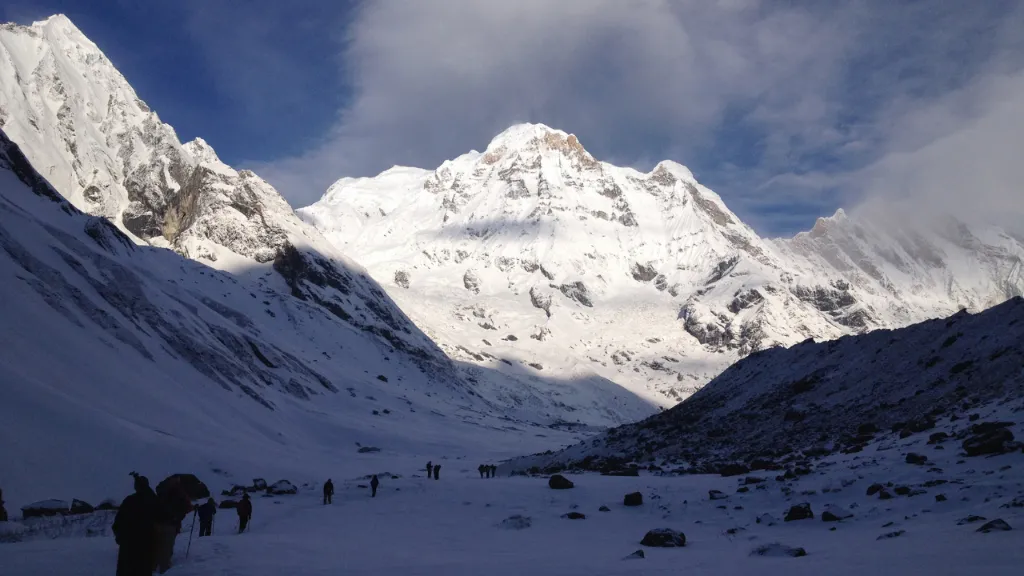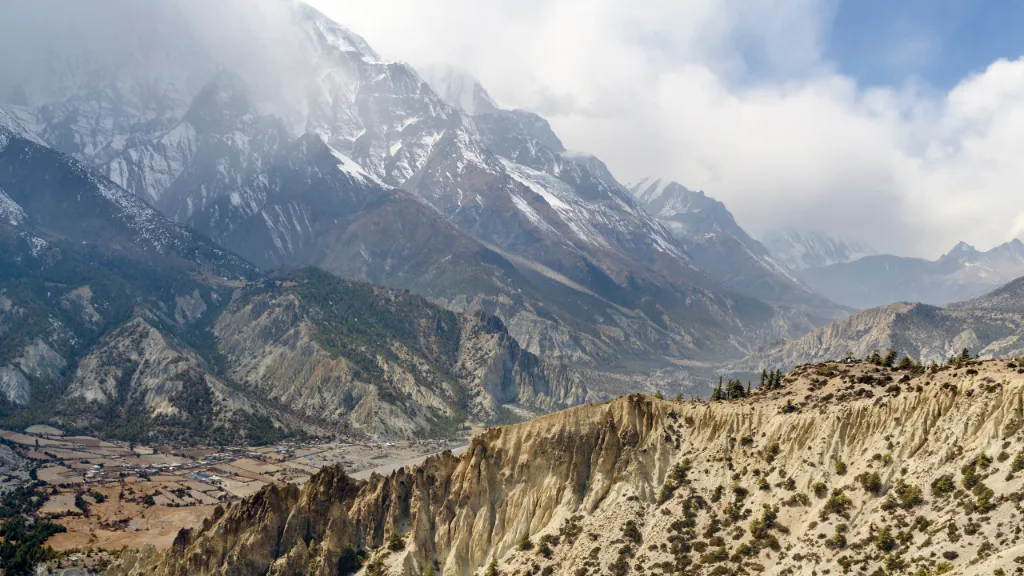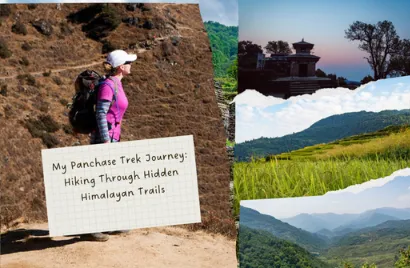Nepal vision | 27/08/2025
The Annapurna region holds some of the most unforgettable trekking trails in Nepal. The Annapurna Base Camp (ABC) Trek and the Annapurna Circuit Trek each offer their own adventure. On either trek, you will see Annapurna I, II, III, IV, Machapuchare (Fishtail), Hiunchuli, Dhaulagiri, Manaslu, and Nilgiri peaks. Each peak stands tall and unique as you move along the trail.
The trails pass through villages and monasteries that bring the mountains to life. You will meet the Gurung, Magar, Thakali, and Tibetan communities. You will see stone houses and prayer flags and feel the local culture in every village.
Although both treks are located in the same region, the trails are quite different. ABC is short and intimate. It passes through rhododendron forests, terraced fields, and flower valleys, and culminates at Base Camp, surrounded by mountains. The Circuit is long and adventurous. It crosses river gorges, alpine deserts, and high passes, including Thorong La. The landscapes change constantly and surprise at every turn.
So which trek should you choose? The peak-close magic of ABC or the high-altitude adventure of the Circuit? Either choice will give you memories that last a lifetime.
Let us begin the journey.
Annapurna Base Camp Trek Overview
Starting with the Annapurna Base Camp (ABC) Trek, you embark on one of Nepal's most iconic journeys, a perfect blend of adventure, nature, and culture. Over the course of 6 to 12 days, you will cover around 110 km and reach a maximum altitude of 4,130 meters.
Along the way, the scenery is unforgettable. You will enjoy 360-degree views of the Annapurna massif, including Annapurna South, Annapurna I, II, III, IV, Machapuchare (Fishtail), Dhaulagiri, Nilgiri, and Manaslu. Additionally, the sunrise at Poon Hill paints the mountains in a golden light. The trail then winds through lush forests, alpine meadows, and river gorges, such as the Modi Khola Valley, ultimately leading to the Annapurna Sanctuary, surrounded by peaks over 7,000 meters high.
Throughout your journey, you will encounter various local cultural communities, including the Gurung, Magar, Thakali, Brahmin, and Chhetri people. Here, Hindu and Buddhist traditions shape daily life, offering a genuine glimpse into Nepalese culture.
Moreover, key stops like Ghorepani, Chomrong, Sinuwa, Bamboo, and Jhinu Danda allow you to stay in teahouses, sample local food, and experience the rhythm of mountain village life.
Although the ABC trek is more leisurely than Everest Base Camp, it still requires good fitness and care. You walk through rhododendron forests, terraced fields, waterfalls, and alpine meadows, over forest paths, stone stairs, rocky trails, and open valleys. Most days, the trek takes 5 to 7 hours, with one longer day of 8 hours to allow for acclimatization and adjustment to higher altitudes.
What Practical Details Should You Know?
- Begin in Pokhara, following a drive or flight from Kathmandu.
- Permits: Annapurna Conservation Area and sometimes TIMS.
- Accommodation: Teahouses; meals and showers may incur additional costs.
- Hot springs: Available at Jhinu Danda.
- Guides and porters: Optional but helpful. Solo trekking is possible.
- Carry Nepali currency, as there are no ATMs on the trail.
- Insurance and preparation are essential. Drones require permission.
Pros and Cons of the ABC Trek
Annapurna Base Camp is the wonder lying in the lap of the Annapurna Himalayas. Despite this, there are several pros and cons to the trail.
Pros
- Breathtaking mountain views.
- Moderate difficulty, suitable for beginners.
- Cultural immersion in villages.
- Hot springs and scenic diversity.
Cons
- Crowds in peak season.
- Altitude sickness risk above 3,000 meters.
- Basic accommodation in some areas. The weather can be unpredictable.
- Some trails are steep and strenuous.

Annapurna Circuit Trek Overview
The classic Annapurna Circuit Trek circles the majestic peaks over a route of about 230 km, passing through terraced fields, dense forests, alpine pastures, glaciers, and finally reaching the high Thorong La Pass at 5,416 m. Along the way, trekkers are greeted by Annapurna I, II, III, IV, Annapurna South, Machhapuchhre (Fishtail), Dhaulagiri, Manaslu, and Tilicho Peak. As you move through picturesque villages and natural landmarks, famous viewpoints like Thorong La, the Marshyangdi and Manang valleys, and serene alpine meadows and lakes provide perfect stops for rest and photos.
One of the trek's significant highlights is the Kali Gandaki, the world's deepest gorge, which adds a dramatic contrast to the landscape. Moreover, the Annapurna Circuit is rich in cultural diversity, passing through remote villages inhabited by the Gurung, Magar, Thakali, Manangi, and Tibetan Buddhist communities. At lower altitudes, Hindu villages showcase terraced farming and traditional rural practices, while higher elevations introduce Tibetan-influenced settlements with monasteries and distinctive mountain architecture. As a result, trekkers gain profound cultural experiences, from participating in local ceremonies and crafts to enjoying the warm hospitality of village life.
Due to the significant elevation gain, many trekkers walk the route in an anticlockwise direction, allowing for a gentler adjustment to higher altitudes. The trek generally takes 12 to 16 days, though shorter or longer itineraries are possible. While the trail combines steady uphill and downhill sections, it also includes challenging high-altitude terrain and cold weather near the pass, making preparation and acclimatization essential for a safe and rewarding journey.
Practical Details for Trekking the Annapurna Circuit:
- Trek usually starts with a drive from Kathmandu to Besisahar or Bhulbhule, the main entry points.
- Permits required: Annapurna Conservation Area Permit (ACAP) and a TIMS card.
- Accommodation: Mostly in teahouses, with food options varying as altitude increases.
- Hot springs: Popular stops near Tatopani and Muktinath.
- Guides and porters: Optional but recommended for safety, especially at high altitudes.
- Money and gear: Carry Nepalese rupees, proper hiking gear, and travel insurance, as ATMs are scarce.
- Trail conditions: Some sections have road construction, making parts accessible by vehicle but slightly reducing the feeling of remoteness.
Pros and Cons of the Annapurna Circuit Trek
Trekking the Annapurna Circuit is a rewarding experience, bute, but it utit also comes with its challenges. Here are the main advantages and drawbacks.
Pros:
- Trekking offers a variety of landscapes and climates.
- Panoramic mountain views include Annapurna I–IV, Machhapuchhre, Dhaulagiri, Manaslu, and Tilicho.
- Rich cultural encounters with Gurung, Magar, Thakali, Manangi, and Tibetan-Buddhist villages.
- Pass through forests, meadows, river gorges, and the Tibetan plateau.
- Experience the Kali Gandaki gorge and the natural hot springs.
Cons:
- High altitude can cause sickness if one is not acclimatized.
- Road construction reduces the remote trekking feel in some areas.
- Trek is long and physically demanding.
- The weather can be harsh at high elevations.
- Certain areas may be crowded in peak season.
How Do ABC and Circuit Differ?
The Annapurna Base Camp (ABC) Trek and Annapurna Circuit Trek differ greatly in duration, altitude, and the scenery you encounter.
Duration:
- ABC Trek: 6–12 days depending on pace and itinerary.
- Annapurna Circuit: 12–16+ days due to longer distance and high passes.
Altitude:
- ABC Trek: Highest point at 4,130 m (13,550 ft).
- Circuit Trek: Crosses Thorong La Pass at 5,416 m (17,769 ft); ranges from 600–800 m to over 5,400 m.
Landscapes:
- ABC Trek: Rhododendron forests, river valleys, terraced fields, alpine meadows, and the glacial Annapurna Sanctuary surrounded by peaks.
- Circuit Trek: Subtropical lowlands, dense forests, deep gorges (Kali Gandaki), alpine pastures, Tibetan dry plateau, exposed rocky terrain near high passes.
Overall Experience:
- ABC: Shorter, lower, and focused on a high alpine basin with lush scenery.
- Circuit: Longer, higher, and diverse; offers dramatic landscapes and cultural variety.
Who Should Choose Which Trek?
Choosing between Annapurna Base Camp (ABC) and the Annapurna Circuit depends on your fitness, time, and what you want from the trek. ABC is best suited for those with limited time or moderate fitness levels. It is shorter, lower in altitude, and still offers fantastic views of mountains, forests, and villages.
The Annapurna Circuit is better for those who are fit, adventurous, and have more time. It is longer, reaches higher altitudes, and showcases a wide variety of landscapes, ranging from lush green valleys to the dry Tibetan Plateau. You also get to see more culture along the way.

To wrap up, both the Annapurna Base Camp and Annapurna Circuit treks offer unforgettable Himalayan experiences, but they cater to different kinds of adventurers. ABC is perfect for a shorter, moderate trek with close-up mountain views and rich village life. The Circuit is ideal for those seeking a longer, higher, and more diverse journey through changing landscapes and cultures.
No matter which trek you choose, the mountains promise memories that last a lifetime.
Ready to plan your adventure? Nepal Vision Treks can help you design the perfect itinerary, arrange permits, guides, and accommodations, and ensure a safe and smooth Himalayan experience. Start your journey today!
FAQs









